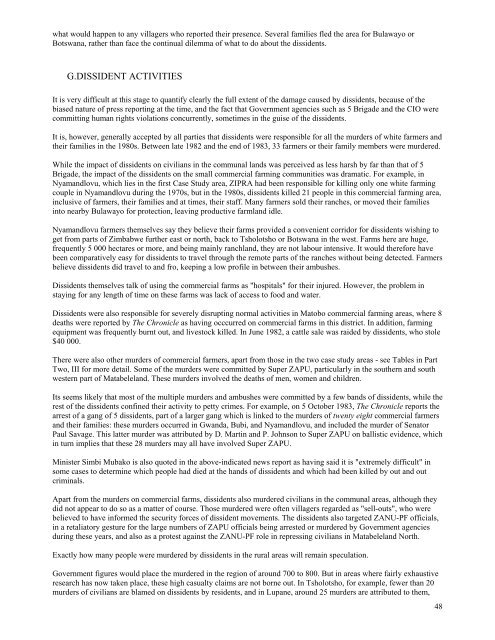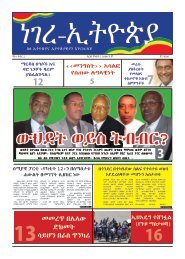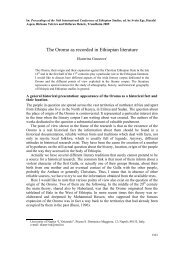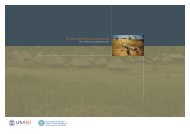MatabelelandReport
MatabelelandReport
MatabelelandReport
Create successful ePaper yourself
Turn your PDF publications into a flip-book with our unique Google optimized e-Paper software.
what would happen to any villagers who reported their presence. Several families fled the area for Bulawayo or<br />
Botswana, rather than face the continual dilemma of what to do about the dissidents.<br />
G.DISSIDENT ACTIVITIES<br />
It is very difficult at this stage to quantify clearly the full extent of the damage caused by dissidents, because of the<br />
biased nature of press reporting at the time, and the fact that Government agencies such as 5 Brigade and the CIO were<br />
committing human rights violations concurrently, sometimes in the guise of the dissidents.<br />
It is, however, generally accepted by all parties that dissidents were responsible for all the murders of white farmers and<br />
their families in the 1980s. Between late 1982 and the end of 1983, 33 farmers or their family members were murdered.<br />
While the impact of dissidents on civilians in the communal lands was perceived as less harsh by far than that of 5<br />
Brigade, the impact of the dissidents on the small commercial farming communities was dramatic. For example, in<br />
Nyamandlovu, which lies in the first Case Study area, ZIPRA had been responsible for killing only one white farming<br />
couple in Nyamandlovu during the 1970s, but in the 1980s, dissidents killed 21 people in this commercial farming area,<br />
inclusive of farmers, their families and at times, their staff. Many farmers sold their ranches, or moved their families<br />
into nearby Bulawayo for protection, leaving productive farmland idle.<br />
Nyamandlovu farmers themselves say they believe their farms provided a convenient corridor for dissidents wishing to<br />
get from parts of Zimbabwe further east or north, back to Tsholotsho or Botswana in the west. Farms here are huge,<br />
frequently 5 000 hectares or more, and being mainly ranchland, they are not labour intensive. It would therefore have<br />
been comparatively easy for dissidents to travel through the remote parts of the ranches without being detected. Farmers<br />
believe dissidents did travel to and fro, keeping a low profile in between their ambushes.<br />
Dissidents themselves talk of using the commercial farms as "hospitals" for their injured. However, the problem in<br />
staying for any length of time on these farms was lack of access to food and water.<br />
Dissidents were also responsible for severely disrupting normal activities in Matobo commercial farming areas, where 8<br />
deaths were reported by The Chronicle as having occcurred on commercial farms in this district. In addition, farming<br />
equipment was frequently burnt out, and livestock killed. In June 1982, a cattle sale was raided by dissidents, who stole<br />
$40 000.<br />
There were also other murders of commercial farmers, apart from those in the two case study areas - see Tables in Part<br />
Two, III for more detail. Some of the murders were committed by Super ZAPU, particularly in the southern and south<br />
western part of Matabeleland. These murders involved the deaths of men, women and children.<br />
Its seems likely that most of the multiple murders and ambushes were committed by a few bands of dissidents, while the<br />
rest of the dissidents confined their activity to petty crimes. For example, on 5 October 1983, The Chronicle reports the<br />
arrest of a gang of 5 dissidents, part of a larger gang which is linked to the murders of twenty eight commercial farmers<br />
and their families: these murders occurred in Gwanda, Bubi, and Nyamandlovu, and included the murder of Senator<br />
Paul Savage. This latter murder was attributed by D. Martin and P. Johnson to Super ZAPU on ballistic evidence, which<br />
in turn implies that these 28 murders may all have involved Super ZAPU.<br />
Minister Simbi Mubako is also quoted in the above-indicated news report as having said it is "extremely difficult" in<br />
some cases to determine which people had died at the hands of dissidents and which had been killed by out and out<br />
criminals.<br />
Apart from the murders on commercial farms, dissidents also murdered civilians in the communal areas, although they<br />
did not appear to do so as a matter of course. Those murdered were often villagers regarded as "sell-outs", who were<br />
believed to have informed the security forces of dissident movements. The dissidents also targeted ZANU-PF officials,<br />
in a retaliatory gesture for the large numbers of ZAPU officials being arrested or murdered by Government agencies<br />
during these years, and also as a protest against the ZANU-PF role in repressing civilians in Matabeleland North.<br />
Exactly how many people were murdered by dissidents in the rural areas will remain speculation.<br />
Government figures would place the murdered in the region of around 700 to 800. But in areas where fairly exhaustive<br />
research has now taken place, these high casualty claims are not borne out. In Tsholotsho, for example, fewer than 20<br />
murders of civilians are blamed on dissidents by residents, and in Lupane, around 25 murders are attributed to them,<br />
48







